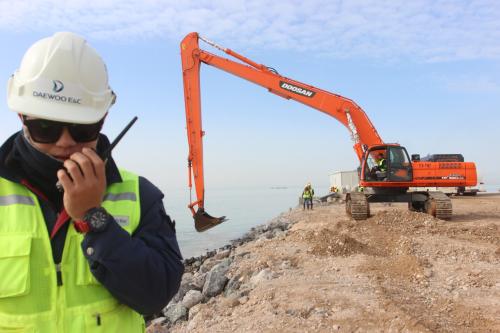Ask finance ministers around the world what they are worried about, and they will likely reply “how to spur economic growth.” They all think they must do something, but the question is what exactly. In the aftermath of the economic crisis of 2008-2009, there has been a revival of interest in industrial policies as governments looked for ways to increase productivity in the face of severely constrained finance. Are industrial policies the best instrument to increase productivity? Or is investing in public goods a better use of scarce resources? Since the heydays of industrial policies in the 1960s, these questions have been hotly debated.
Industrial policies consist of targeted government interventions to promote specific economic sectors with the aim of increasing their productivity and spreading positive externalities throughout the economy. The main theoretical justification for industrial policies is the need to address market imperfections. In an environment with full information and strong governance, the optimal design of industrial policies is in principle a simple matter: Policymakers should invest selectively to take advantage of the externalities and spillovers that some sectors have relative to others. In practice, however, governments face two key issues: their imperfect knowledge of existing constraints, incentives, and opportunities across the economy; and their vulnerability to corruption, manipulation, and rent-seeking. Developing countries—which tend to have weaker institutions and lower capacity to implement complex policies—may thus face greater risks when pursuing industrial policies.
Can the uncertainty about which sectors to invest in be overcome? Dani Rodrik proposes that industrial policy be viewed as a discovery process, whereby the public and private sectors collaborate to identify underlying costs and opportunities. In a recent report, the Inter-American Development Bank describes several instances of collaboration across Latin America, including the sugarcane industry in Argentina, the tourism industry in Costa Rica, and shipbuilding programs in Uruguay. This type of public-private collaboration, however, is hampered by the risk that the private sector might profit from its informational advantage and derive excessive rents by capturing government. Consider, for instance, the case of the rice industry in Costa Rica: Private involvement in the institution in charge of managing policies for the rice sector have resulted in excessive support to rice producers and a decrease in agricultural productivity. Consider also the recent experience in Tunisia: Firms highly connected to former president Ben Ali were found to be most present in protected sectors including telecoms, automobiles, and tourism. Governments, therefore, face a dilemma: To overcome the uncertainty that clouds the design of industrial policies, collaboration with the private sector may be necessary, but this could lead to state capture.
Not all industrial policies are the same, however. They can vary between “vertical” policies that favor specific firms or narrow sectors and “horizontal” policies that target broad sectors by improving their business environment. The more “horizontal” these policies are, the more they approach the characteristics of public goods. Countries around the world have implemented industrial policies with varying degrees of success. An analysis of Chilean industrial policy, for instance, describes the use of several vertical and horizontal policy instruments, though with a growing emphasis on the latter in recent years. Horizontal industrial policies used in Chile include guarantees for loans to small enterprises, subsidies to new exports, and a program to foster innovation; while vertical industrial policies feature the creation of a semi-public entrepreneurial institution—Fundación Chile—and a program to attract foreign direct investment in technology. As is often the case with vertical industrial policies, Fundación Chile has had a few huge successes, including the development of the salmon and blueberry industries, but also many failed projects, such as the cultivation of the southern hake.
Given the risks associated with industrial policies, policymakers should consider the best match between their government capacity and the type of policy to be pursued. Vertical policies require greater capability to both implement policies and avoid corruption than do horizontal policies. For example, while tax incentives have been widely used to attract new investment and spur economic growth, including in Singapore and Korea, the cost of implementing and enforcing these policies can be particularly high. Further, these implementation costs generally increase with the complexity of subsidies and taxes involved in vertical industrial policies. A committee reviewing the use of tax incentive policies in Papua New Guinea, for instance, highlighted a concern about the challenges of implementing or effectively monitoring research and development and infrastructure incentives in the face of scarce administrative and technical capacity.
In a recent paper, we review the debate on industrial policies. Moreover, we present an analytical framework that captures the informational problems and trade-offs that policymakers face when choosing public goods (e.g., public information, infrastructure, and law and order) or targeted industrial policies (e.g., firm or sector-specific subsidies, grants, and tax breaks). The model attempts to capture the possibility that private entrepreneurs may misrepresent information about the social value of their firms or industry in order to obtain special treatment from the government. We explore an optimal industrial and tax policy that is robust to uncertainty about firm-specific productivity. It requires, however, substantial government capacity, as the planner must be able to set firm-specific taxes that are a function of firms’ claimed productivity. The model then explores sub-optimal but simpler policies, which are more appropriate when the planner does not have the ability to set up an elaborate tax and compliance system. In this, more realistic, context, the model finds that providing public goods tends to be preferable to industry or firm-specific industrial policies.
Evidence and theory point in the same direction: When there is uncertainty regarding which firms and sectors have the greatest growth potential and when government capacity is low and subject to corruption, narrow industrial policies should be avoided in favor of interventions that benefit the majority of firms and induce competition. When the pressure to do something for growth is acute and mounting, more public goods and less preferential treatment are best.
This blog post draws from “Industrial Policies vs Public Goods under Asymmetric Information” by Constantino Hevia, Norman Loayza, and Claudia Meza-Cuadra (World Bank Policy Research Working Paper No. 6628). Interested readers are invited to see it for an expanded discussion of the evidence and specifics on the analytical framework.
The Brookings Institution is committed to quality, independence, and impact.
We are supported by a diverse array of funders. In line with our values and policies, each Brookings publication represents the sole views of its author(s).







Commentary
Industrial policies versus public goods to spur growth
June 29, 2017